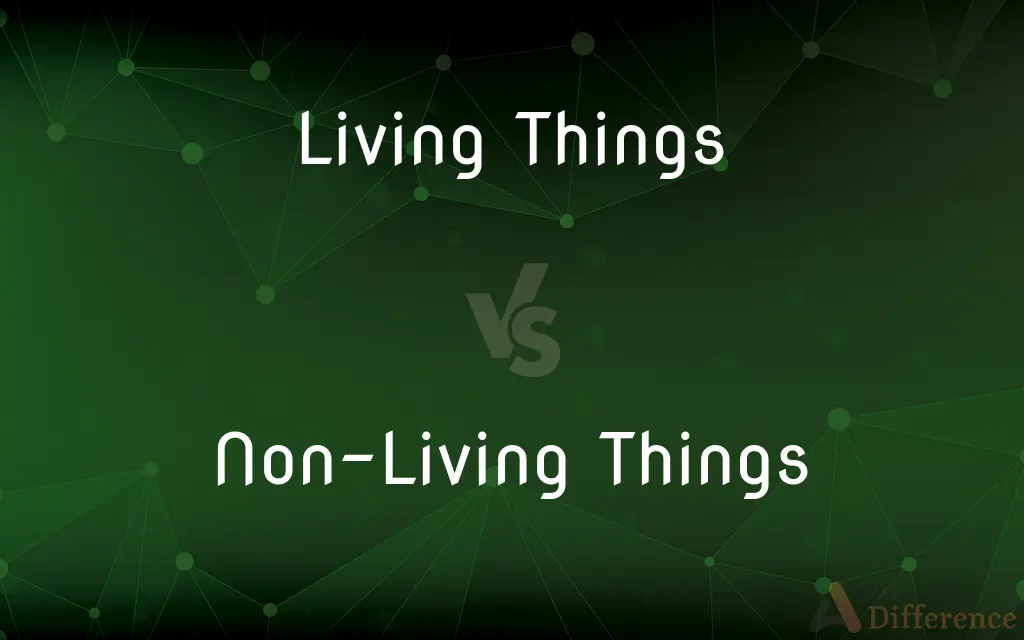Living Things vs. Non-Living Things — What's the Difference?
By Tayyaba Rehman — Published on December 12, 2023
Living Things exhibit growth, reproduction, and metabolism; Non-Living Things don’t.

Difference Between Living Things and Non-Living Things
Table of Contents
ADVERTISEMENT
Key Differences
Living Things are entities that have the ability to grow, reproduce, take in nutrients, and respond to their environment. In contrast, Non-Living Things lack these abilities and are not composed of cells, the fundamental unit of life.
Living Things possess a life cycle – they are born, mature, reproduce, and eventually die. Non-Living Things, on the other hand, don’t have a life cycle; they exist until they wear out or break down, but they don't grow or evolve organically.
Metabolism is a unique characteristic of Living Things; they convert food to energy, get rid of waste, and repair themselves. Non-Living Things do not have metabolic processes; they don't consume energy in the same way organisms do.
Responsiveness to external stimuli is a key characteristic of Living Things. They can adapt or react to changes in their environment. Non-Living Things, conversely, do not respond to stimuli and don't adapt or change unless acted upon.
At a cellular level, Living Things are made up of one or more cells, which are the basic units of life. Non-Living Things, however, are not made up of cells and lack cellular structures or functions.
ADVERTISEMENT
Comparison Chart
Basic Unit
Cells
Atoms/Molecules
Growth
Grow organically
Do not grow
Responsiveness
Respond to stimuli
Do not respond to stimuli
Reproduction
Have the ability to reproduce
Cannot reproduce
Metabolism
Exhibit metabolic processes
Lack metabolic processes
Compare with Definitions
Living Things
Entities characterized by cell-based structures and the ability to adapt.
Trees adjust their growth direction based on sunlight, showcasing the adaptability of Living Things.
Non-Living Things
Items that lack cell-based structures and cannot adapt.
A metal rod doesn't change or adapt on its own, representing Non-Living Things.
Living Things
Beings that undergo a life cycle from birth to death.
From caterpillar to butterfly, the metamorphosis exemplifies the lifecycle of Living Things.
Non-Living Things
Objects that don’t exhibit growth, reproduction, or metabolism.
A rock remains static over time, a typical feature of Non-Living Things.
Living Things
Objects with the ability to intake nutrients and expel wastes.
Humans eat food and expel waste, a characteristic of Living Things.
Non-Living Things
Things without life processes or responsive abilities.
Water in a bottle doesn’t respond to external changes, a characteristic of Non-Living Things.
Living Things
Organisms that can grow, reproduce, and sustain metabolic processes.
Plants and animals are Living Things.
Non-Living Things
Entities that don’t possess a life cycle or consciousness.
A book remains the same unless acted upon, an attribute of Non-Living Things.
Living Things
Things that possess consciousness or life processes.
Birds migrating during seasons highlight the conscious behaviors of Living Things.
Non-Living Things
Materials that can’t intake nutrients or expel wastes.
A glass window remains unchanged without intake or output, showcasing Non-Living Things.
Common Curiosities
Can Non-Living Things ever become Living Things?
No, Non-Living Things can't spontaneously become Living Things.
Are all Living Things made up of cells?
Yes, all Living Things are made up of one or more cells.
What differentiates Living Things from Non-Living Things?
Living Things grow, reproduce, and sustain metabolic processes, while Non-Living Things don’t.
Do both Living Things and Non-Living Things exist in every environment?
Yes, both are found everywhere, from deep oceans to deserts.
Can Living Things exist without Non-Living Things?
No, Living Things rely on Non-Living Things, like water and minerals, for survival.
Do Non-Living Things have a lifespan?
No, they persist until they wear out or break down, but they don’t have a life cycle like Living Things.
Are viruses considered Living Things or Non-Living Things?
Viruses are a gray area; they show characteristics of life when inside a host but are inactive outside a host, like Non-Living Things.
How do Living Things interact with Non-Living Things?
Living Things use Non-Living Things for sustenance, shelter, and other necessities.
Are robots Living Things or Non-Living Things?
Robots are Non-Living Things, although they may mimic some behaviors of Living Things.
Can Living Things turn into Non-Living Things?
Yes, when they die or are transformed into inanimate objects or substances.
Can Non-Living Things be made from Living Things?
Yes, products like leather and wood come from Living Things but are considered Non-Living.
Can Non-Living Things transform over time?
Yes, but through physical or chemical changes, not organic growth or evolution.
Can Non-Living Things exhibit movement?
Yes, but through external forces or mechanisms, not organic processes.
What’s the smallest known Living Thing?
Microbes, like bacteria, are among the smallest Living Things.
Why is metabolism significant for Living Things?
Metabolism helps Living Things convert food to energy, remove waste, and repair themselves.
Share Your Discovery

Previous Comparison
Metallic Minerals vs. Non-metallic Minerals
Next Comparison
Wild Buffalo vs. BisonAuthor Spotlight
Written by
Tayyaba RehmanTayyaba Rehman is a distinguished writer, currently serving as a primary contributor to askdifference.com. As a researcher in semantics and etymology, Tayyaba's passion for the complexity of languages and their distinctions has found a perfect home on the platform. Tayyaba delves into the intricacies of language, distinguishing between commonly confused words and phrases, thereby providing clarity for readers worldwide.
















































